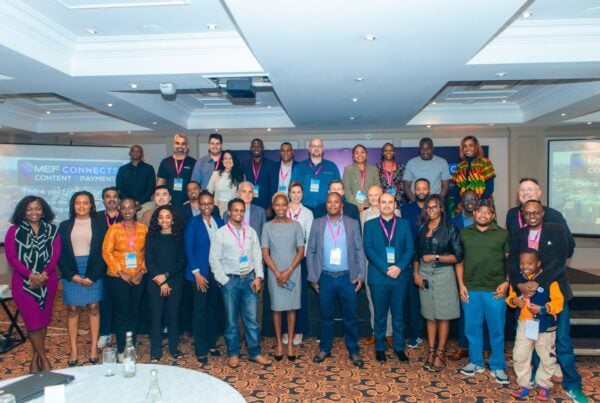Location is the key ingredient in the best mobile advertising, says specialist Verve. This is why it believes transport-oriented apps could be as valuable as those of any famous media brand.
MEF Minute met Verve’s Julie Bernard and Ian James to find out more about this insight and the general direction of the mobile ad space.
The digital ad ecosystem is insanely complex. Insanely.
In the Mad Men era, an ad exec instinctively knew where her customers were. They were reading the Wall Street Journal. Or watching ESPN. Or sitting at a bus shelter
So she called the publisher on the phone and booked an ad. Job done

Now, to repeat, it’s not so simple. The digital ad space is controlled by robots. Brands plug in their preferences and the bots wait for consumers to land on a given page. The ‘brand bot’ negotiates a price with the ‘publisher bot’ and the ad is displayed.
This all happens at the speed of light.
Needless to say there are multiple participants in this new value chain. Diagrams like this reveal just how many.
This complexity is the cause of much anguish. Who are all these companies? Why are they shaving fractions of dollars off all these opaque transactions?
One gets the sense sometimes that even those who work in advertising don’t understand it.
So any companies in the space with a clear business model and a unique offering stand out. This is where Verve comes in.
If you were to sum up Verve in three sentences, they would be as follows:
- Its ad tech is all about location
- It does clever location stuff inside the device, not on the cloud
- When you buy Verve’s tech, you also buy its creative executions
When you think about it, location is the obvious differentiator for a mobile-focused ad tech company.
After all, it’s the thing that makes a phone different from a PC.
Verve founder Tom Kenney recognised this as early as 2005, when the mobile web barely existed and ad tech comprised of the odd text alert. He had the realisation while working at Nokia Ventures.
Today, Verve works with the biggest companies in the world (L’Oreal, Ford, Pepsi, Starbucks etc) and the agencies that support them. It places their location-centric ads across a family of high traffic apps. Crucially, it embeds an SDK inside these apps to determine their location (rather than relying on the network to do the work).
It can then marry this accurate location information with other data sets to make ads that are relevant at that exact moment.
And the results are impressive.
Take the example of Krispy Kreme. It created a National Doughnut Day (any excuse, right?), and gave away a free doughnut to anyone who visited their stores.
Verve targeted a custom audience segment of Quick Serve Restaurant Frequenters and served ads to anyone in this cohort that was also within a 5-mile radius of a Krispy Kreme outlet.

Verve’s creative executions include ‘tap to map’
Crucially, it also crafted a creative campaign to maximise its impact. This included a ‘Tap to Map’ feature.
The results showed 2.31 per cent tapped to locate a nearby outlet. This exceeded previous engagement benchmarks by 25 per cent.
Case studies like this, says Verve’s chief marketing officer Julie Bernard, illustrate the necessity for a combination of tech and creative.
“You really can do magical things in mobile with location intelligence,” she says. “But it’s all irrelevant if you have a horrible creative. We find a lot of advertisers come to us with TV ads that they want to re-purpose from horizontal to vertical and cut from 30 seconds to six. It doesn’t work. And it is also time to reinvent the static banners and interruptive interstitials we all recognise in mobile advertising.”
“This is why we always offer a packaged service. We match the location audience development and targeting with more magical mobile creative. And that’s where great results come from, with more value for advertisers and high CPMs for publishers.”
Verve has strong ideas about what works on mobile. Alongside ‘tap to map’, it offers a host of other formats such as:
- A button to let people save an ad to their Home screen to view later at their convenience.
- Banners that scroll horizontally when a user scrolls up and down
- Vertical video – obvious, but most ads are shot horizontally
- Short six second video ads with no audio
- Ads that are also games, with tilt, scratch and shake functions
To repeat, Verve is serving these ads inside a family of popular native apps. What’s interesting is the ascendancy of utility apps in this grouping alongside those offering entertainment and news.
Ian James, CEO for international business at Verve, believes this is an intriguing market development.
He says: “We’re getting to the point where bus checker apps can, in some respects, deliver better ad results than something like the Guardian. Bus checker apps will have location turned on by default and people will look at these apps multiple times a day. They offer a straightforward ad proposition that has an elegance to it. You might not get this in very busy news apps.
“So perhaps we over emphasise the entertainment factor when we think about the app space. Utilities are extremely important. I think there’s huge potential there.”
Bernard believes the location-centric ad space is just at the beginning of its potential. Verve is now exploring what can be done when you embed payment forms inside an ad. Users can already click to a dedicated checkout page. The next step is adding Apple or Android Pay to let people pay inside the ad itself. “I think it’s inevitable that there will be closer integration between mobile ads and mobile wallets,” she says.
Then there’s VR and AR. In February, Verve partnered with Digital Domain to supply 360° video for its platform. The aim is to investigate how to blend localised ad placements with dramatic new creative executions.
If this means more doughnuts more quickly, it has every chance of success.




